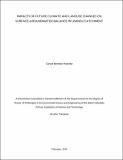| dc.description.abstract | This study was undertaken to assess the impacts of future climate and land use/cover changes on surface-subsurface water balance in Usangu catchment, located in the Southern highlands of Tanzania. The objectives of the study were achieved through i) use of stable isotopic compositions of water (18O and 2H), determination of major dissolved ions (K+, Na+, Mg2+, Ca2+, Cl-, CO32-, SO42-) and dissolved silica (SiO2) for rainfall, rivers, springs and wells to assess the origin, flow pathways and hydrological interconnections of water sources, ii) use of Markov Chain and Cellular Automata models to predict land use/cover change of the whole catchment, iii) use of a simple delta change downscaling method to generate 2010-2039 climate scenario from the General Circulation Models (GCMs), iv) use of Soil and Water Assessment Tool (SWAT) to assess future impacts of land use/cover and climate changes on surface and subsurface water balance, taking Ndembera River watershed as case study, and v) evaluate the effectiveness of water and land management practices as the remedies for the adverse impacts of future land use/cover and climate changes on water resources. The isotopes compositions of water for rivers, wells and springs indicated a recharge by recent meteoric water. Usangu catchment has two flow pathways; a short springs-rivers flow system with low concentrations of dissolved ions, and a slow deeper-aquifer flow pathway which is disconnected from rives and springs. The changes in land use/cover affected water resources negatively. At the whole Usangu catchment scale, from 2013 to 2020, the urban and agricultural lands were predicted to increase by 8.2% and 1%, respectively, while forestlands would decrease by 20.6%. For Ndembera River watershed alone, the area under agriculture and evergreen forest would increase by ~10% and 7%, respectively. Also, forestland would decrease by ~12%, and in turn, would decrease the total water yield by ~13%, while the evapotranspiration and overland runoff would increase by ~8% and ~18%, respectively. The period 2010-2039 was shown to be warmer (1.1ᵒC) and wetter (about 2-7% in the wet months) than the baseline period (1980-2009), exacerbating the adverse impacts of land use/cover change. Water stress in the catchment caused by future climate and land use/cover changes could be reduced by management practices such as filter strips, grassed waterways and terracing and contouring. | en_US |

